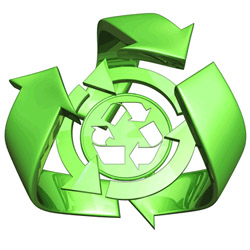
Image courtesy / www.ecosherpa.com
Happy Earth Day! Today is the day we take a moment to appreciate all Mother Earth gives us and resolve to do a better job of returning the favor.
While so many of us have made incredible strides in our efforts to live a greener life, many of us have a long way to go. Individuals can certainly lead the way on this front, but businesses have an even bigger responsibility – and often a bigger platform – in which to encourage a green lifestyle.
Last week I had a conversation with a business owner about making his office more environmentally friendly. Many of the products he uses for his business are green, but the office itself needs some improvement on that front (no paper recycling, throw-away cups by the coffee pot).
While this business owner wasn’t opposed to bettering the environment, he questioned the finances – why pay someone to gather the recycling when it can be tossed in the trash? It’s a valid question for businesses concerned about the bottom line, particularly in our current economic climate.
The warm fuzzies of knowing you’re helping the environment doesn’t pay the bills so how best to convince companies to go green?
It starts with the employees. If your boss is hesitant to implement some green initiatives, show him or her why it makes sense. And, Earth Day is the perfect day to begin.
• Gather like-minded co-workers and form a green team. Have lunch together and plan your strategy.
• Start small. What are three green initiatives you can tackle that won’t cost the company any money? Those could include asking everyone to shut down the desktop computers at the end of the day to conserve energy. Ask your co-workers to bring a coffee mug from home instead of using the Styrofoam cups. Put a box near your desk for batteries, e-waste and other hard-to-recycle items and volunteer to take them to the nearest collection agency once a month.
• Track the savings. For example, figure out how much the company is saving when employees print fewer documents – it’s a savings of printer ink, paper costs and printer maintenance.
• Once you have a few months of results, schedule a meeting with your boss and present a proposal for a green office. Provide statistics and hard data to demonstrate that with a little upfront cost, the company could be saving money. And again, start small. Ask that a small amount of money be dedicated to green efforts. As your boss sees the benefits, the budget will most likely grow.
If you work for a small company where the boss’ office is just down the hall, this might be a little easier. But even if your company is large, you can take the same approach and start with the branch manager or department supervisor, who can help you work your way up the chain of command.
For inspiration, we give a Green Thumbs Up to The Center for Natural Dentistry in Encinitas, Calif., north of San Diego. The center is a holistic dental practice “integrating natural procedures with traditional science-based dentistry.”
This dental practice chose April to announce its green initiatives, which not only include use of low-wattage fluorescent lights and low-flow toilets, but a host of other environmentally friendly practices:
• Eco-friendly cleaning solutions.
• Reusable towels to reduce waste.
• On-site, energy-efficient laundry facility to reduce waste.
• Bio-hazard disposal policies to ensure toxic chemicals (such as mercury) don’t pollute the environment.
• Comprehensive Patient Protection Program to ensure mercury vapors don’t pollute the air or patients’ lungs.
• Paperless records to reduce paper consumption and waste.
Please share the ways in which you’ve initiated the green movement at your office. We’d love to hear your ideas.
[ add comment ] ( 38 views ) | [ 0 trackbacks ] | permalink |




 ( 3 / 2874 )
( 3 / 2874 ) 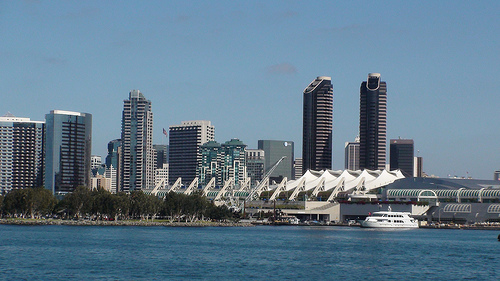
photos courtesy Port of San Diego
When it comes to implementing green policies and practices at your business or organization, much of the success depends on being flexible, open to change and willing to work with like-minded businesses. That’s a lesson from the Port of San Diego and its Green Port Program. The port achieved a number of its goals for the first year of the program, but was willing to adapt and partner.
The Green Port Program covers six areas: water, energy, air, waste management, sustainable development and sustainable business practices.
Kelly Makley, associate environmental specialist in the port’s Environmental Services Department, said the port intended to have a green purchasing policy in place by the end of 2008. “It was one of those things that was taking a lot longer than we thought, but it ended up being a good thing,” Makley said.
Working closely with the port’s Procurement Department, the goal was to assess and consider environmental impacts during the procurement process and make selections that would have the least detrimental impact on the environment. “We thought it would be easy,” Makley said. “We started working on it and realized how much it was going to change the way the Procurement Department does business.”
Rather than tossing out the whole idea, the port was flexible and decided to test its plan internally, trying out some products, such as recycled paper and toner cartridges as well as some hybrid vehicles. “We’ll take this year to test it out internally in the Procurement Department, so when we go to the (port) board at the end of 2009 or in early 2010, we’ll have the data to give them,” Makely said.

And then there are the surprise opportunities that make going green a truly worthy endeavor.
One of the Green Port Program’s most exciting initiatives, Makley said, was forming a partnership with San Diego Gas & Electric. The two signed a memorandum of understanding to work together on energy issues. The public utility company conducted an energy audit and created an Energy Road Map with recommendations for how to retrofit the port facility to make it more energy efficient.
SDG&E recommended about $120,000 of retrofits, including changing out light fixtures and using a Vending Miser, a product that manages power usage of a vending machine by monitoring temperature changes and whether someone is in the same room. Modifications to outdoor lighting and the some use of solar panels also were on the list of recommendations.
The best part is SDG&E offers loans to fund these retrofits. For example, Makley explained, SDG&E would loan the port $1,000 for a new energy-efficient light fixture. The savings on the port’s energy bill goes back to SDE&G to repay the loan. Once the loan is repaid, the port will start seeing that savings on its bill.
“SDG&E is interested in working with public entities,” Makley said. “SDG&E has to increase its renewable energy use, so it’s trying to be proactive and work with people like us to be more efficient.”
The port also partnered up with Nissan and SDG&E to showcase Nissan’s new line of electric cars. The port hosted a news conference on its Broadway Pier earlier this month and community leaders took the vehicles for a spin. San Diego is one of the first markets to try out the new electric vehicles. And Makley said she expects the port will test a couple. By adding 13 hybrids to its fleet last year, the port has saved 550 gallons of fuel.
In your company’s efforts to go green, what surprise encounters have you had? Did you partner with another business or organization to achieve your green efforts?
[ add comment ] ( 64 views ) | [ 0 trackbacks ] | permalink |




 ( 3 / 2562 )
( 3 / 2562 ) 
A big Green Thumbs Up this month to Sprint. At the Sprint headquarters campus in Overland Park, Kan., the company has been committed to green efforts for a number of years. When the headquarters was constructed about 12 years ago, it turned a water recapture system into a duck pond that houses a variety of wildlife and captures water runoff from the 225-acre campus. The company does composting on site (pictured below), and 75 percent of the HQ energy use comes from wind power.
But that’s just some of the many ways Sprint is green. The Green Office Blog talked with Alicia R. Martin, sustainability manager, real estate for Sprint, and Alex Hahn, Sprint community and public relations manager, about the company’s green efforts. Martin shared a long list of green initiatives, including green parking, composting, an energy management program, waterless urinal trials, LED garage lighting trials, a bicycle commuter incentive program, prairie grass restoration, natural pesticides, green cleaning and discounted refills for drinks in reusable cups.
An important part of Sprint’s green office program is executive-level support. Even though the company has been focused on the environment for more than a decade, CEO Dan Hesse – who joined Sprint in December 2008 – has made it a top priority. “He made it clear to all that the environment is and will be a key priority for Sprint and he published it as one of the pillars of his corporate scorecard,” Martin explained. This kind of executive support, she added, is one of the best ways Sprint has been able to maintain its focus on green efforts.
Show them the money
In this down economy, businesses may be tempted to cut “unnecessary” items, such as recycling programs or switching to energy-efficient light bulbs. But Sprint has shown green efforts can save companies a sizable amount of money.
• In January 2008, Sprint removed all foam cups from break rooms across the nation and offered reusable cups to interested employees. The savings: $135,000 a year. And this effort kept 5 million cups a year out of the trash.
• Last year, the company implemented Sprint Mobile Workforce, which allows employees the opportunity to work from home. Not only does it foster work/life balance and give employees greater flexibility, it saved Sprint $20 million annually.
As Martin pointed out, it’s tough to argue with policies and practices that save millions of dollars.
Think before you print
Most offices use plenty of paper, and Sprint was no exception. Martin said printing less was one of the easiest ways to make the office greener.
• Think about which documents are really needed in hard copy form.
• Use virtual or online tools. Sprint’s iDigitize program encourages employees to use PDF printing to desktop or eCopy Desktop as well as scanning or e-mailing documents.
• Fax from the desktop, using WebFax or other software.
• Eliminate cover pages.
• Use laptops. Hahn said Sprint likes to use PowerPoint presentations, but instead of printing a copy of the presentation for everyone, employees simply bring their laptops to the meeting and follow along on the computer.
In 2007, Sprint purchased 59 million fewer sheets of 8 ˝ x 11 paper. The savings: $295,000 annually, not to mention saving about 7,000 trees.
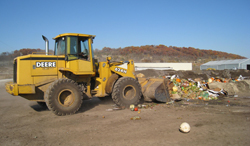
Good-bye, trash cans
Hahn works in the company’s Reston, Va., office where desk trash cans have been replaced with recycling bins. The goal is to change employees’ habits, he said. It gets them consciously thinking about whether they should throw something away or recycle it.
Martin said the Sprint HQ will be eliminating a similar trial program on a smaller scale. The short-term goal is to recycle more, she said, but the ultimate end goal is to see recycling numbers go down because the company is simply using less.
Start small
It can be easy to get wrapped up in the green movement and think you have to take on the biggest project, but Martin advises to start small.
“Do not get caught up in trying to have every initiative and every program perfect before rolling it out. Take small steps when and where you can, track your metrics from the very beginning and add new programs as opportunities arise. Eventually, the small steps and new efforts will evolve into a robust program that you and your company can be proud of. “
Want more info on Sprint? Follow the company on Twitter @SprintGreenNews.
If your company would like to be featured as a Green Office Profile, send an e-mail to holly (at) hollyannfisher.com.
[ 2 comments ] ( 258 views ) | [ 0 trackbacks ] | permalink |




 ( 3 / 2535 )
( 3 / 2535 ) You’ve invested time and resources into your green office initiatives. You’ve encouraged employee interest and involvement. You’ve even cut some costs through such minor changes are limiting use of paper and installing a programmable thermostat.
You’re just about ready to give yourself a nice, big green pat on the back only to find your customers, your suppliers, your vendors or maybe even your industry colleagues are sucking the green out of your office with their not-so-sustainable actions.
So, what’s a green office to do? If you’ve fostered great business relationships, you don’t want to dump them just because they have Styrofoam cups by the office coffee pot.
First and foremost, walk the walk. Put “lead by example” into practice. The next time a customer comes in, offer her coffee or water in a mug or glass. Offer to send documents via e-mail rather than handing him a thick folder of paper. Or suggest a teleconference for the next meeting. Often a message comes through loud and clear without a big speech. Besides, you want to seem helpful, not condescending.
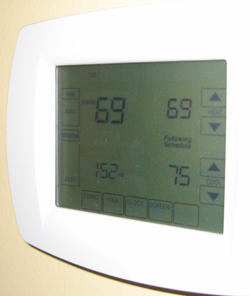
Second, give concrete examples of what has worked for you. Consider sharing how you’ve saved energy costs by using a programmable thermostat or turning the heat down a couple of degrees. Talk about how allowing employees to telecommute two days a week hasn’t lessened productivity and has helped air quality. Plus, employees are happy to save a few bucks on gasoline.
Some people will embrace the idea of going green simply because they have an appreciation for the environment. Other people need to know what’s in it for them, so don’t be afraid to share how green has benefited your company. Here’s a good article from treehugger.com on seven ways to save money by making your office green.

(Photo/AZAdam)
Third, give a green gift. When you’re looking for a way to thank a big client or recognize a vendor who went above and beyond, think green. Send over coffee mugs with your company logo (sending the subtle message your customer can dump the throw-away cups). Drop off some information on local recycling or composting programs. Give away some energy-efficient light bulbs.
We posed this question via Twitter and found folks are thinking along similar lines:
• From @SprintGreenNews: For wireless recycling, we focus our efforts on increasing 3 items: 1) incentive, 2) ease 3) awareness.
• From @environmentsite: Show them the money.
• From @operationcarbon: I think it's a perfect opportunity to introduce ideas to them and explain the benefits of going green.
How do you handle this situation? How have you shared your green ideas with customers, vendors or industry colleagues?
This week’s Green Thumbs Up goes to Frito-Lay and UPS. Check out this story from GreenBiz.com about how Frito-Lay is adding fuel-efficient delivery vehicles to its fleet, while UPS adds compressed natural gas delivery trucks.
[ 1 comment ] ( 114 views ) | [ 0 trackbacks ] | permalink |




 ( 3 / 2376 )
( 3 / 2376 ) 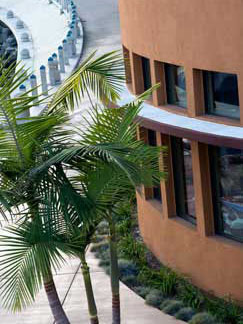
Photos courtesy Sun Harbor Marina
It’s one thing to add some recycling bins to your office or install a programmable thermostat. It’s another to build more than 17,000 square feet of buildings and 100 boat slips with a mission of sustainability.
Sun Harbor Marina did just that. Located in the San Diego Harbor, the marina complex became the first marina to receive Leadership in Energy and Environmental Design certification. And what makes this feat even more impressive is that the project started in 2003 at a time when sustainable building – even in California – wasn’t as easy as it is now.
Much of the credit for the marina’s LEED certification and green vision goes to former managing partner Mary Lou LoPreste, who purchased Sun Harbor Marina and undertook a marina renovation project like none other.
Kathy OBrien, property manager, says LoPreste felt strongly about the environment and wanted to make sure she was doing whatever she could to preserve the environment and make it a healthier place – not just for today but for future generations.
LoPreste partnered with architect Caitlin Kelley and the green efforts began. The project was completed in March 2005 and the U.S. Green Building Council awarded LEED certification the following year.
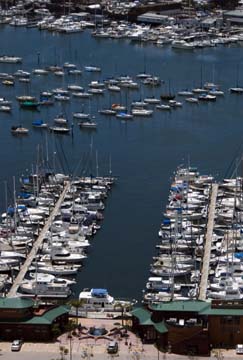
Sun Harbor Marina is three buildings and 100 boat slips. Whenever possible, sustainable materials and green building practices have been used. Sun Harbor followed the LEED specifications, one of which is purchasing building materials locally.
One of the challenges at that time, OBrien says, was finding sustainable materials that were available locally or if they did exist, there weren’t multiple suppliers. “That has changed greatly,” she notes. “For several products, now there are more options. Now you can go to Home Depot.”
Some of the sustainable products used to construct Sun Harbor Marina include:
• VOC-free paints.
• Bamboo cabinetry.
• Recycled carpet.
• Rubber baseboards.
• Low-flow facets and toilets.
Also the glazing on the windows reflects the heat, keeping the heat out in the summer and the cool air out in the winter. The number of windows also provides plenty of natural light and eliminates the constant need for overhead lighting. When the lights are used, they automatically adjust to match the natural light, only getting brighter as it gets darker outside.
The facility’s thermostats are only active when someone is physically in the space, and office equipment shuts itself when not in use.
The marina has its own recycling center, and tenants – including yacht brokers, law offices and a restaurant – are encouraged to recycle. OBrien says many tenants came to Sun Harbor specifically because it is LEED certified (take note, developers).
A few additional pieces of advice from OBrien:
• Take advantage of all the resources that are available now. Jump on Google and search any item you want and chances are hundreds of resources will appear.
• Look to CFL light bulbs or LED lighting.
• Check the amount of recycled content in the carpet you’re installing.
• When having your HVAC system serviced, make sure proper filters are being used.
• For cabinetry, use sustainable materials, such as bamboo.
• Sun Harbor has slate and tile in the restrooms – easily available and sustainable materials.
• When looking for a physical location, consider your proximity to a bus stop or other mass transit options.
• Offer parking for bikes and a place to shower, making it easy for employees to bike to work.
• Take a look at the kinds of supplies you’re using: toilet paper, soaps, cleaning products. There are plenty of green options.
Finally, OBrien suggests talking to people who have green buildings and offices. Find out how they did it and visit their facilities. Some people think building green means having an ugly building, but Sun Harbor Marina is anything but ugly, and OBrien encourages people to take a look. “It doesn’t have to be ugly. You can be proud of the facility.”
And we offer a hearty Green Thumbs Up to Sun Harbor Marina for taking on green even at a time when green was a lighter shade than it is today. If Sun Harbor can go green, surely the rest of us can take a few more steps in the green direction.
[ 1 comment ] ( 279 views ) | [ 0 trackbacks ] | permalink |




 ( 3 / 2035 )
( 3 / 2035 ) 


 Looking for a Green Office Solution?
Looking for a Green Office Solution?